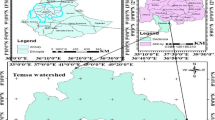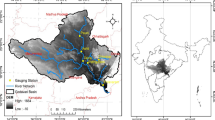Abstract
Low flow in the river is an important parameter that directly impacts on various water management activities. Therefore, the study of long-term low flow records is essential for managing sustainable water resources in a river basin. The impacts of climate change on water resources has shown a significant change in river discharge, making the study of low flow trends and its variability even more crucial. Trends of the various magnitude of low flows such as 1-day min flow, 3-day min flow, 7-day min flow, 30-day min flow, 90-day min flow for 14 stations over Mahanadi River basin India are studied using the Modified Mann Kendall test. Further, the multivariate Bayesian change point analysis has been carried out for detecting the significant change year. The results obtained show an increasing trend in the low flow in the upper part of the Mahanadi River basin as most of the stations. Which are showing a decreasing trend of low flow indices are present in the upper part of the basin. This study concludes the presence of a mixed low flow trend, i.e., increasing, decreasing, and some stations with no trend. From Multivariate Bayesian change point, analysis advocates that there is evidence of some significant change point in all the stations between the period 1995 and 2006. The analysis revealed that the Mahanadi River basin is highly vulnerable to low flow conditions driven by the variability in low flow discharge, which may be linked to an increase in anthropogenic activities in the basin.
Similar content being viewed by others
References
Asokan SM, Dutta D (2008) Analysis of water resources in the Mahanadi River Basin, India under projected climate conditions. Hydrol Process 22:3589–3603
Bassiouni M, Oki DS (2013) Trends and shifts in streamflow in Hawai ‘i, 1913–2008. Hydrol Process 27:1484–1500
Bastia F, Equeenuddin SM (2016) Spatio-temporal variation of water flow and sediment discharge in the Mahanadi River, India. Global Planet Change 144:51–66
Behera M et al (2018) Remote sensing based deforestation analysis in Mahanadi and Brahmaputra river basin in India since 1985. J Environ Manage 206:1192–1203
Bormann H, Pinter N (2017) Trends in low flows of German rivers since 1950: comparability of different low-flow indicators and their spatial patterns. River Res Appl 33:1191
Chisholm IM, Hubert WA, Wesche TA (1987) Winter stream conditions and use of habitat by brook trout in high-elevation Wyoming streams. Trans Am Fish Soc 116:176–184
Dadhwal VK, Aggarwal SP, Mishra N (2010) Hydrological simulation of Mahanadi river basin and impact of land use/land cover change on surface runoff using a macro scale hydrological model. In: Wagner W, Székely B (eds) Proceedings of ISPRS TC VII symposium—100 years ISPRS, Vienna, Austria, July 5–7, Part 7B, vol 38. The international archives of the photogrammetry, remote sensing and spatial information sciences (IAPRS), Vienna, Austria, pp 165–170
Dare MR, Hubert WA, Gerow KG (2002) Changes in habitat availability and habitat use and movements by two trout species in response to declining discharge in a regulated river during winter. N Am J Fish Manag 22:917–928
Das P et al (2018) Impact of LULC change on the runoff, base flow and evapotranspiration dynamics in eastern Indian river basins during 1985–2005 using variable infiltration capacity approach. J Earth Syst Sci 127:19
Diop L, Yaseen ZM, Bodian A, Djaman K, Brown L (2017) Trend analysis of streamflow with different time scales: a case study of the upper Senegal River ISH. J Hydraul Eng 24:1–10
Douglas E, Vogel R, Kroll C (2000) Trends in floods and low flows in the United States: impact of spatial correlation. J Hydrol 240:90–105
Dunham JB, Rosenberger AE, Luce CH, Rieman BE (2007) Influences of wildfire and channel reorganization on spatial and temporal variation in stream temperature and the distribution of fish and amphibians. Ecosystems 10:335–346
Erdman C, Emerson JW (2007) bcp: an R package for performing a Bayesian analysis of change point problems. J Stat Softw 23:1–13
Gajbhiye S, Meshram C, Singh SK, Srivastava PK, Islam T (2016) Precipitation trend analysis of Sindh River basin, India, from 102-year record (1901–2002). Atmos Sci Lett 17:71–77
Gilbert RO (1987) Statistical methods for environmental pollution monitoring. Wiley, New York
Goswami BN, Venugopal V, Sengupta D, Madhusoodanan M, Xavier PK (2006) Increasing trend of extreme rain events over India in a warming environment. Science 314:1442–1445
Hannaford J, Marsh T (2006) An assessment of trends in UK runoff and low flows using a network of undisturbed catchments. Int J Climatol 26:1237–1253
Hisdal H, Stahl K, Tallaksen LM, Demuth S (2001) Have streamflow droughts in Europe become more severe or frequent? Int J Climatol 21:317–333
Hörmann G, Horn A, Fohrer N (2005) The evaluation of land-use options in mesoscale catchments: prospects and limitations of eco-hydrological models. Ecol Model 187:3–14
Huntington TG (2006) Evidence for intensification of the global water cycle: review and synthesis. J Hydrol 319:83–95
Hyvärinen V (2003) Trends and characteristics of hydrological time series in Finland. Hydrol Res 34:71–90
India-WRIS (2018) Dams in Mahanadi Basin. https://www.india-wris.nrsc.gov.in/wrpinfo/index.php?title=Dams_in_Mahanadi_Basin. Accessed 20 June 2018
Isaak DJ et al (2010) Effects of climate change and wildfire on stream temperatures and salmonid thermal habitat in a mountain river network. Ecol Appl 20:1350–1371
Kormos PR, Luce CH, Wenger SJ, Berghuijs WR (2016) Trends and sensitivities of low streamflow extremes to discharge timing and magnitude in Pacific Northwest mountain streams. Water Resour Res 52:4990–5007
Kothyari U, Singh V (1996) Rainfall and temperature trends in India. Hydrol Process 10:357–372
Libiseller C, Grimvall A (2002) Performance of partial Mann-Kendall tests for trend detection in the presence of covariates. Environmetrics 13:71–84
Lins HF, Slack JR (1999) Streamflow trends in the United States. Geophys Res Lett 26:227–230
Mantua N, Tohver I, Hamlet A (2010) Climate change impacts on streamflow extremes and summertime stream temperature and their possible consequences for freshwater salmon habitat in Washington State. Clim Change 102:187–223
McBryan T, Anttila K, Healy T, Schulte P (2013) Responses to temperature and hypoxia as interacting stressors in fish: implications for adaptation to environmental change. Integr Comp Biol 53:648–659
Nasr A, Bruen M (2017) Detection of trends in the 7-day sustained low-flow time series of Irish rivers. Hydrol Sci J 62:947–959
Ng H, Marsalek J (1992) Sensitivity of streamflow simulation to changes in climatic inputs. Hydrol Res 23:257–272
Panda DK, Kumar A, Ghosh S, Mohanty R (2013) Streamflow trends in the Mahanadi River basin (India): linkages to tropical climate variability. J Hydrol 495:135–149
Pattanayak S, Nanjundiah RS, Kumar DN (2017) Linkage between global sea surface temperature and hydroclimatology of a major river basin of India before and after 1980. Environ Res Lett 12:124002
Perreault L, Parent E, Bernier J, Bobee B, Slivitzky M (2000) Retrospective multivariate Bayesian change-point analysis: a simultaneous single change in the mean of several hydrological sequences. Stoch Environ Res Risk Assess 14:243–261
Prowse TD, Culp JM (2003) Ice breakup: a neglected factor in river ecology. Can J Civ Eng 30:128–144
Raje D (2013) Changepoint detection in hydrologic series of the Mahanadi River basin using a fuzzy Bayesian approach. J Hydrol Eng 19:687–698
Risbey JS, Entekhabi D (1996) Observed Sacramento Basin streamflow response to precipitation and temperature changes and its relevance to climate impact studies. J Hydrol 184:209–223
Sen PK (1968) Estimates of the regression coefficient based on Kendall's tau. J Am Stat Assoc 63:1379–1389
Sen Roy S, Balling RC (2004) Trends in extreme daily precipitation indices in India. Int J Climatol 24:457–466
Smakhtin VU (2001) Low flow hydrology: a review. J Hydrol 240:147–186
Sonali P, Kumar DN (2013) Review of trend detection methods and their application to detect temperature changes in India. J Hydrol 476:212–227
Stahl K et al (2010) Streamflow trends in Europe: evidence from a dataset of near-natural catchments. Hydrol Earth Syst Sci 14:2367–2382
Stocker T (2014) Climate change 2013: the physical science basis: Working Group I contribution to the Fifth assessment report of the Intergovernmental Panel on Climate Change. Cambridge University Press, Cambridge
Tabari H, Taye MT, Willems P (2015) Statistical assessment of precipitation trends in the upper Blue Nile River basin. Stochastic Environ Res Risk Assess 29:1751–1761
Tharme RE (2003) A global perspective on environmental flow assessment: emerging trends in the development and application of environmental flow methodologies for rivers. River Res Appl 19:397–441
Wang X, Emerson JW (2015) Bayesian Change point analysis of linear models on graphs arXiv preprint. arXiv:150900817
Worland SC, Farmer WH, Kiang JE (2018) Improving predictions of hydrological low-flow indices in ungaged basins using machine learning. Environ Model Softw 101:169–182
Yue S, Wang C (2004) The Mann-Kendall test modified by effective sample size to detect trend in serially correlated hydrological series. Water Resour Manag 18:201–218
Author information
Authors and Affiliations
Corresponding author
Ethics declarations
Conflict of interest
The authors declare that they have no conflict of interest.
Additional information
Publisher's Note
Springer Nature remains neutral with regard to jurisdictional claims in published maps and institutional affiliations.
Rights and permissions
About this article
Cite this article
Sahoo, B.B., Jha, R. Assessment of low flow trends and change point detection in Mahanadi River basin, India. Sustain. Water Resour. Manag. 6, 81 (2020). https://doi.org/10.1007/s40899-020-00441-4
Received:
Accepted:
Published:
DOI: https://doi.org/10.1007/s40899-020-00441-4













